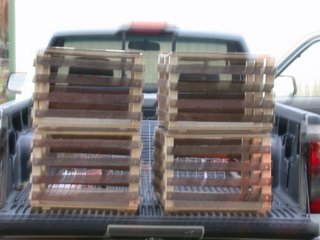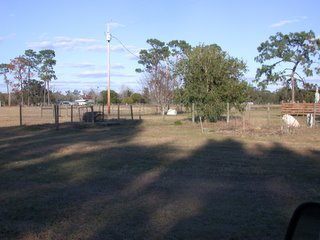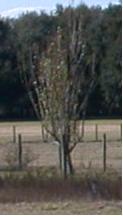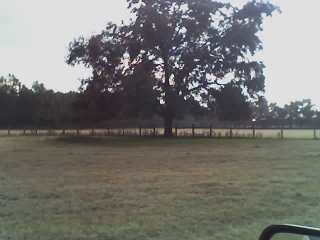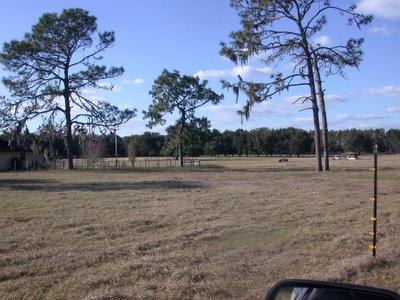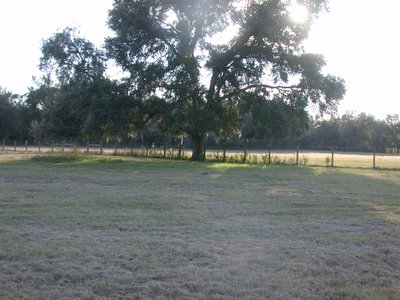
Here’s the deal, I’m a farmer and I can’t walk.
Do you know how someone who can’t walk can take care of all the chores and projects on a small farm?
Do you know how anyone, no matter their physical situation, can take care of all the chores and projects on a small farm?
First they come to the realization that it is pretty much impossible, and then they do the best they can.
How does a farmer, any farmer, turn a stand of grass into a barn full of hay? Turn a bull calf into a steer? Not by physical prowess or force of personality, I promise you.
Are you tall? Fat? Mechanically gifted or all thumbs? Can you think like a cow? Do you know what that ram is likely to do next? Yah, me either. We all have issues.
We use tools. A tractor is a tool. So is a barn. A squeeze chute for cattle is a tool. Some of these things are more or less standardized while some are completely home grown. Most are customized at least to some extent. There is a lot of science in this, but more art than science.
I’ve heard it said that it takes five years to learn to farm any given piece of ground. I wouldn’t know because I haven’t been here five years yet. This assumes that you know a lot about farming in general already, the five years is just to learn the ground.
I’m a software engineer aside from being a farmer. I can’t imagine needing five years to learn a software application, a computer language, and operating system. I’d be on food stamps. My father was a University Professor. He had a PHD. He claimed he did that because he wasn’t smart enough to be a farmer. He was joking when he said that, but only kind of, he knew the truth of it. His father was a farmer.
Is this a post about dealing with physical limitations? the complexity of farming? a how to guide for farming from a wheelchair? Yes, yes, and of course not.
If you do an internet search on farming with a disability you will find a bunch of articles on how some farmer somewhere modified some tool or piece of equipment to overcome a physical limitation. University or USDA types mostly write these articles. They go into all sorts of detail about the particulars of the adaptation. It looks to me like lots of government grant money went into this work. I can tell you exactly how many people can make use of the adaptation just as they describe it. Exactly one, the farmer that did it in the first place.
The other thing you get back from a search like that is any number of examples of how a poorly conceived adaptive device can convert a disabled farmer into a dead one. Of course one does not have to be disabled to get killed trying to farm. More than any thing else, good judgment is necessary in this line of work. Good judgment comes from experience. Experience, to often, comes from poor judgment. I’ve noticed that pretty much any time I mess up in my farming endeavors, something dies. It is best if that something is not human. It may be that forgetting ones physical limitations and failure to think a process all the way through to its conclusion is the cause of most farm accidents.
Farming is a profession firmly based in reality. It is all about life and death. I expect soldiers and cops know how this is.
So the title of this post is “Figuring out how to do it”. I’ll share what I think I know. None of this has anything to do with disability.
Every rural area I’ve ever been around has someone who is the go to guy for metal fabrication. This guy is your friend. Around here it’s Johnnie Lee at Lee’s Custom automotive in Lake Butler. It’s not just Johnnie, it’s a family business, but Johnnie’s the man. He is much like anyone who is very good at what they do; he is an enthusiast. For him an unusual project is fun.
If you need for example, hand controls for your tractor, and go to the regular implement dealer, you will just get the bums rush. If they are honest they will tell you why. If you hurt yourself using some adaptive device they make for you they are afraid you will sue them. They have a point. The tort system in general and the A.D.A. in particular have converted disabled people from potential customers into potential lawsuits.
There is a good chance that they don’t have anyone there who could help you anyway. This is a completely custom job. Tractors are all different as are all would be tractor drivers. One size does not fit all.
All good farmers need and use custom tools. It has nothing to do with disabilities. There is a whole system of rural artisans that service this need. I need these guys more than most farmers do, and a lot more than they need me.
A farm is the great cosmic gizmo. It is a living thing that is in a state of continuous change and adjustment. Small changes are best. Make a change and observe the results. Repeat as necessary.
Here is an example. I have about 20 sheep. This time of year it's good to give them some supplemental feed. I have hay, which is only just fair quality grass hay and they can also graze the pastures for whatever they can find among the dormant grasses. That gives them all the forage they need, but I decided a little more would be best. I'm feeding soy meal as a supplement.

The first method was the most obvious. I put a wooden feed trough in the center of a part of the barn the sheep had access to. Because the animals could get to every side of the trough they could all eat at once. Two problems with this approach, the greedy little buggars mob me when I come in with the feed, and I end up spending quite a bit of time cleaning the manure out of the tread on my wheelchair tires. Otherwise my bride won't let me back in the house.

A way to feed without actually getting in with the critters started to seem like a good idea. So I moved the trough against the wall where I could fill it through the boards.
OK, new problem. Now they can't all eat at once. The more aggressive sheep eat too much, the less aggressive sheep don't get enough.
The first attempt at fixing this was to mix 30 lbs of salt with each 100 lbs of soy meal. The salt keeps the sheep from eating until the feed runs out. The aggressive sheep eat first, but they wander off before its all gone and give the other sheep a chance to eat.
Well, that's better, but it is now difficult to tell how much the sheep are being fed over all. It is possible to calculate how much a sheep should be fed at different times of the year, but it is not possible to control it this way.
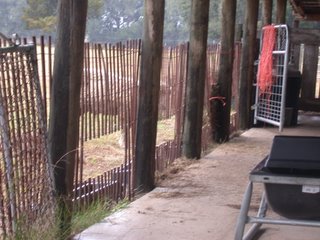
This is the current state of affairs, enough trough space for them to all eat at once, where I can feed without getting in with the sheep.
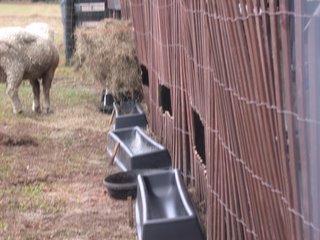
 Last summer John allowed me to turn my two heifers in with his herd to get them bred. I just installed a gate in our common fence and led them over.
Last summer John allowed me to turn my two heifers in with his herd to get them bred. I just installed a gate in our common fence and led them over. 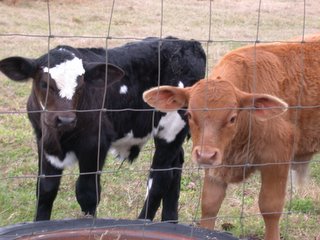
 Since I go down the lane every day I get to witness the calf races and other games they play when they are still young and cute.
Since I go down the lane every day I get to witness the calf races and other games they play when they are still young and cute.

